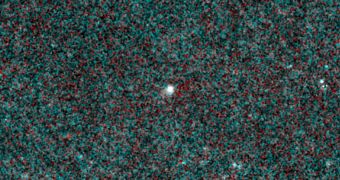A large number of spacecraft currently on the surface of Mars, or in orbit around the planet, will get a unique opportunity to study a comet up close this spring, when an object called 2013 A1 Siding Spring will pass 10 times closer to our neighboring world than any comet as flown past Earth.
Officially dubbed C/2013 A1, the comet was first discovered on January 3, 2013, by astronomers using the Siding Spring Observatory, in Australia. The object will reach its point of closest approach to Mars on October 19, 2014, when it passes about a third of the Earth-Moon distance from the Red Planet.
When first discovered, the relatively large ball of ice and dust was located beyond the orbit of Jupiter. Even before it makes its pass by Mars, dust and ice particles released by its nucleus will threaten orbiters currently around our neighboring world.
NASA now has two spacecraft around Mars, the Mars Reconnaissance Orbiter and the Mars Odyssey, while the European Space Agency (ESA) operates the Mars Express satellite. Both agencies are at the moment developing measures to ensure these vehicle remain safe from any danger.
As the comet passes by the planet, before reaching its point of closest approach at 138,000 kilometers (86,000 miles), these orbiters may get the chance to image C/2013 A1's core in great detail.
“Our plans for using spacecraft at Mars to observe comet Siding Spring will be coordinated with plans for how the orbiters will duck and cover, if we need to do that,” explains the chief scientist of the Mars Exploration Program, Rich Zurek, from the Jet Propulsion Laboratory (JPL), in Pasadena, California.
The American space agency has already announced plans to use the recently resurrected NEOWISE mission and the Hubble Space Telescope to study the comet. The ground-based NASA Infrared Telescope Facility will also contribute to characterizing the comet as it nears Mars.
Astronomers are currently pinning their hopes on the High Resolution Imaging Science Experiment (HiRISE) aboard MRO for providing the best views of the cometary core. This instrument is basically an extremely-sensitive camera attached to a large telescope.
Additional observations will be conducted by the Mars Science Laboratory (MSL) rover Curiosity and the Mars Exploration Rover (MER) robot Opportunity. These two assets will be surveying the skies over their respective locations on the surface of Mars for any potential signs of meteorites produced by the comet.
“A third aspect for investigation could be what effect the infalling particles have on the upper atmosphere of Mars. They might heat it and expand it, not unlike the effect of a global dust storm,” Zurek concludes.

 14 DAY TRIAL //
14 DAY TRIAL //